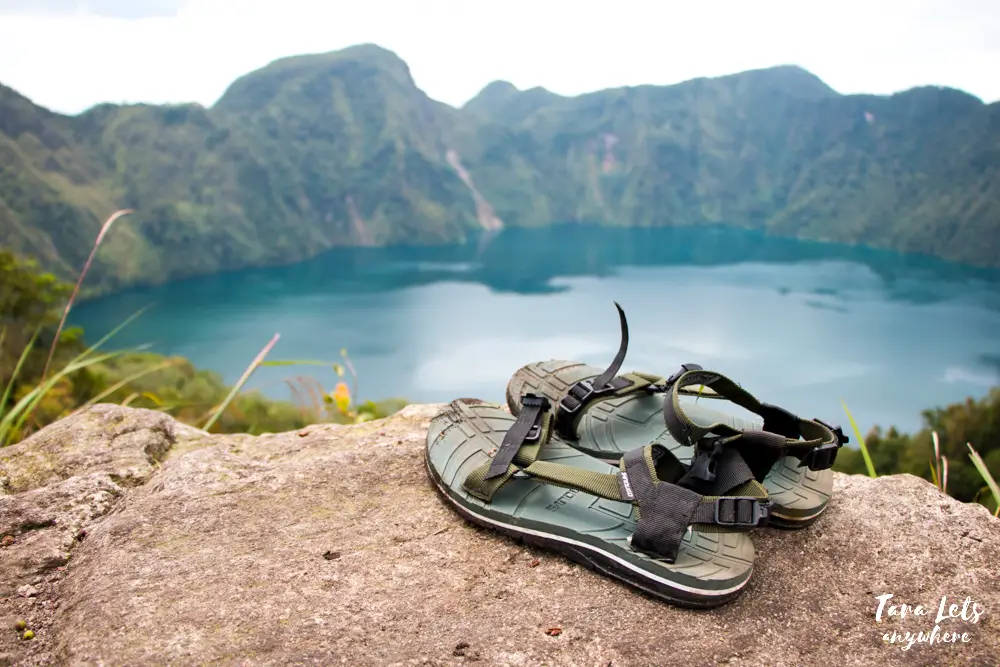
Lake Holon: Gem of South Cotabato (Guide + How to Get Here)
Lake Holon is one of the hidden gems in Mindanao and a perfect destination for adventurers. It offers a lot of activities including trekking, swimming and kayaking in the lake, and cultural immersion with the locals in the indigenous community. Here’s our guide to Lake Holon in Tboli, South Cotabato.
Contents
My trip to Lake Holon
I went here during a 5-days backpacking trip in Mindanao in 2016 with my friend Kharl. Our first destination is Samal Island in Davao before we eventually headed to the Tboli in South Cotabato.
We arrived early at the town proper and registered at the tourism office. From there, we rode motorcycles to the briefing site, where we would start the trek to Lake Holon. The roads were rough and steep, and it was a good thing that the motorcycle drivers were experienced in the trails. I was relieved that it wasn’t muddy or rainy.
The briefing site consists of a cottage that displays cultural artifacts, such as gongs. Life is simple in the Tboli community — it takes you back in time. There were no cemented roads, lots of horses for transport, and houses made with bamboo and wood.
A woman named Mylene oriented us about Lake Holon. She explained that Lake Holon is a water-filled crater in Mount Parker, which is locally known as Mount Melibengoy. It’s similar to Mount Pinatubo’s crater lake. The two names Parker and Holon are named after the Americans that claimed to have discovered the mountain in 1934.
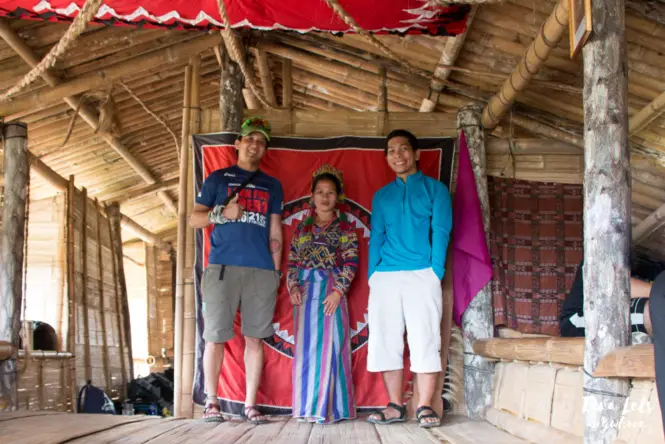
After the briefing, we prayed for a safe trek and then off we went.
There are two starting points to reach Lake Holon: Sitio Kule and Salacafe. We started at Sitio Kule, where we saw fields of tall grasses and corn.
The trek is a good 2-3 hours and it’s ideal for intermediate trekkers. There were lots of trees, though some patches in the mountain were noticeable where kaingin might have been practiced. We also saw a hot spring, although it’s not recommended for dipping due to sulfuric content. Despite the boiling bubbles, the hot spring was actually not very hot.
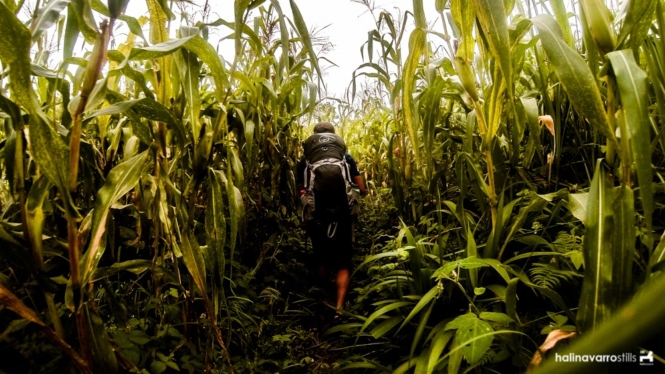

Finally, we reached the view deck to the lake.
I was in awe seeing the lake from our vantage point. The lake was surrounded by lush mountains. It’s reminiscent of the view in Mount Pinatubo. The difference is that the water has a greenish hue due to sulfur in Mount Pinatubo, whereas the water is a clear blue and safe for swimming in Mount Holon.
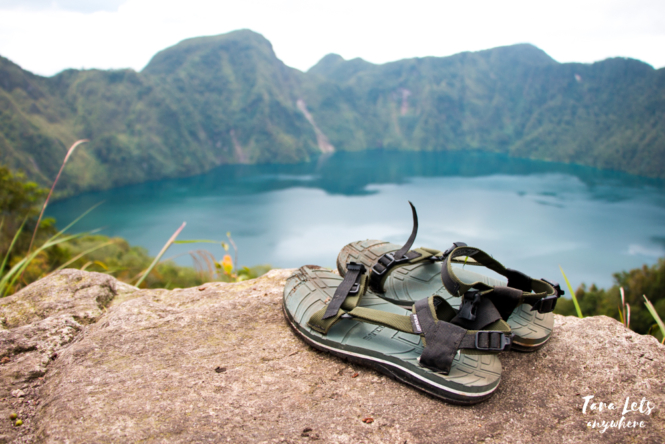
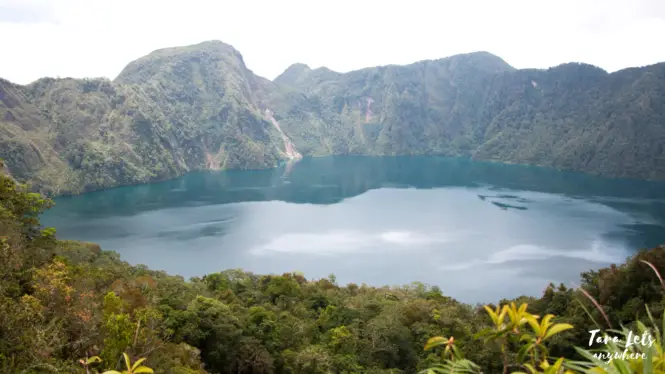
There was a dog waiting for us in the view deck. It was friendly and it accompanied us when we continued the trek to reach the area where we had to ride a boat to the campsite.
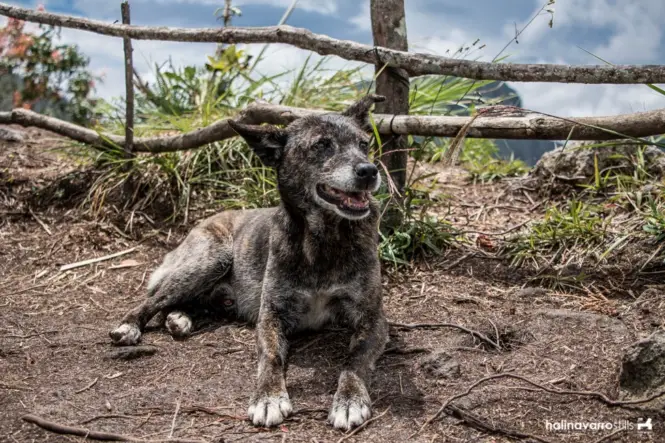
That day, we were the only ones to visit Lake Holon. We had the whole place to ourselves, from the trail to the lake view. Our guides told us that weekends are usually different — it is more crowded.
We settled on tents in the campsite.
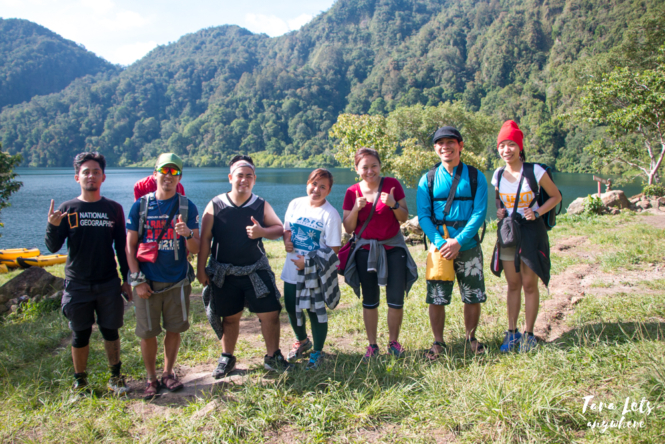

Surprisingly, the dog from earlier was there with us to camp. It must’ve taken a shortcut that didn’t require a boat ride. He was with a pack of 10 or more dogs. They were friendly and playful. They looked at us as if expecting treats with their puppy dog eyes.
The use of life vest and kayak was free on the campsite. There was also a diving area. The water was clear from a distance and we even noticed that the locals didn’t have to venture far to catch fish. Some just waited patiently at the shore.
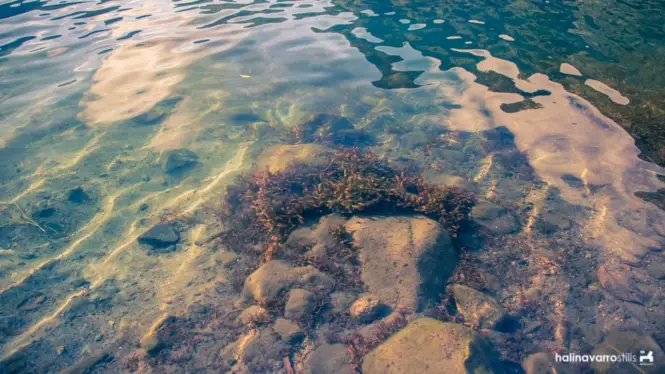
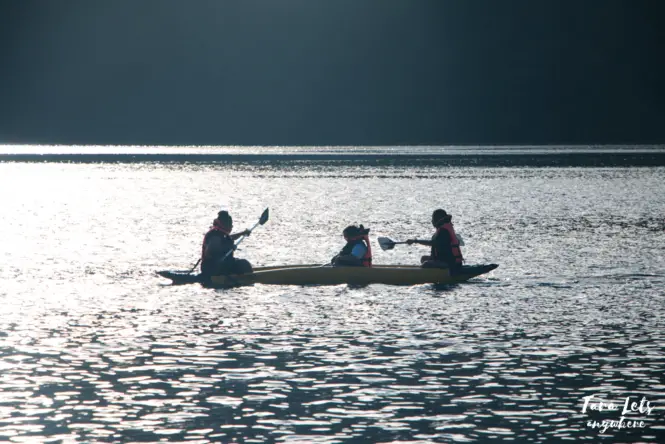
I went on kayak alone. I’m guessing that it must take 2 hours or more from the campsite to reach the other end of hte lake. I tried to go to the other end, but I only reached the middle. The current was a bit different in the middle area and I was pulled in circles when paddling. So I decided to head back.
We camped for the night. As early as 7PM, I was astonished to see that the Milky Way was already visible in the sky. This is the first time I’d seen it clearly during that hour. I’d always thought that it could only be seen after midnight. Perhaps the lake’s distance from the cities and the simplicity of life helps the place steer clear of pollution, for the galaxy to show up so early.
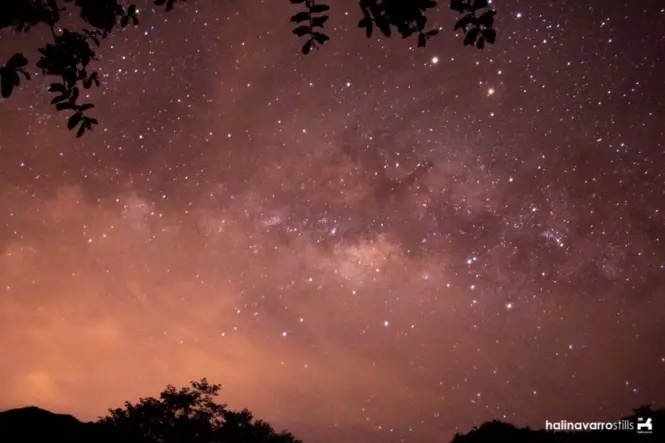
The next morning, I took a dip at the diving area. I couldn’t resist jumping in the water where there is diving involved. The water was cold.
We ate our breakfast and then prepared to leave. We took a different route going back — the Salacafe Trail. The dogs joined us on our trek back to the briefing site. It was nice but also a bit hassle because the dogs fell in line with us in the single trail.
Along the way back is a Tboli community that sells bamboo mugs for P25. The mugs are a nice souvenir to take home. I brought two for myself and another one as gift.

We took a good rest on our stopover and waited for habal-habals to take us to the Bakngeb Cave River, which is another 30-40 minutes ride way. There we took a raft to get to a cave and ended up jumping in a spot near the mouth of the cave.
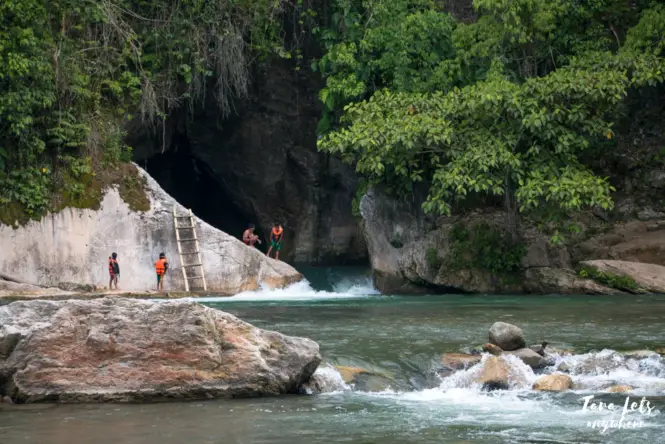
Afterwards, we continued our trip. We went to the Hinatuan Enchanted River in Surigao del Sur before we headed back to Manila.
About Lake Holon
Lake Holon is also known as Lake Maughan. It is considered the Crown Jewel of the South.
It’s a crater lake in Mount Parker in Tboli, South Cotabato. It spans over 300 hectares and it is 4,700 feet above sea level. Visits to Lake Holon are regulated and only a certain number of visitors are allowed per day.
It’s one of the best ecotourism sites in the Philippines. It’s part of the ecotourism circuit of the Tboli Tribe, which also includes nearby attractions: Bakngeb Cave, Lamhaku Hot Spring and Hidak Falls & Hikong Kemebel.
Lake Holon is one of the few crater lakes in the Philippines. Others include Mount Pinatubo and Taal Volcano in Tagaytay.
How to get to Lake Holon
There are different ways to get to Lake Holon in South Cotabato. General Santos is the nearest commercial airport.
From General Santos
- From the airport, head to Bulaong Terminal. Travel time is 30-45 minutes.
- From the terminal, ride a bus bound for Marbel in Koronodal City. Travel time is 1-1.5 hour, and fare is around P75 per person.
- From Marbel, ride a van bound for Tboli and get off at the tourism office. Travel time is 45 minutes to 1 hour, and fare is P60 per person.
From Davao
- Head to the terminal in G-Mall or SM City Davao. From there, ride a van bound for Marbel. Travel time is 4 hours, fare is around P300 per person.
- From Marbel, you can follow the same instruction as above.
Trek to Lake Holon
Register at the Tboli Tourism Office and pay the necessary feees.
From the tourism office, ride a habal-habal to the jump-off point for one of the two trails that lead to Lake Holon — Kule Trail or Salacafe Trail, which are both located in the same barangay. Travel time is 1.1.5 hour either way.
Once you arrive at the jump-off point, you need to attend a short orientation about do’s and don’ts and what you can expect on your visit. The orientation in Kule Trail is held in a cottage and the speaker is usually a woman in traditional Tboli attire. It’s interesting because you can see a glimpse of the Tboli culture and also take photos.
Here are the two trails to Lake Holon:
- Kule Trail. Also called Hunter’s Trail. This is a difficult trail, but it’s usually taken by visitors because it passes by the view deck, which offers the best view of Lake Holon. The trail includes 3-4 hours of trekking, depending on your pace. You’ll come across 5 stations — the fourth one of which is the view deck.
- Salacafe Trail. This trail also takes 3-4 hours, but the route is easier. It’s ideal for less-experienced trekkers. But do not underestimate it — it still includes assault from the start up to descent to the lake. This trail offers only a view of a portion of the lake.
So which one should you choose? It’s recommended to take the Kule Trail on entry and then Salacafe Trail on exit. This way, you’ll get to experience both.
After the trek, you will need to take a 5-minute boat ride to get to the campsite.
2 Days itinerary to Lake Holon
Lake Holon is not ideal for a day hike. Due to its remote location, you will need to spend overnight to enjoy Lake Holon.
Here’s a sample 2 days itinerary to Lake Holon:
| Day 1 | 8AM Registration at the tourism office 8:30 – 9:30AM Habal-habal to jump-off area 9:30 – 10AM Orientation 10AM – 2PM Trek via Kule Trail / stopover at viewdeck / boat ride to campsite 2PM onwards – free time *You can swim, kayak, fish, and have bonfire at night |
| Day 2 | 6 – 9AM Sunrise watching / breakfast / morning swim 9AM Pack up 9:30 – 10AM Trek from campsite to jump-off area 10AM – 2PM Trek back via Salacafe Trail 2 – 3PM Habal-habal back to tourism office |
Once you arrive back at the Tboli Tourism Office, you will be given a certificate for conquering the trek to Lake Holon.
Things to know before you go
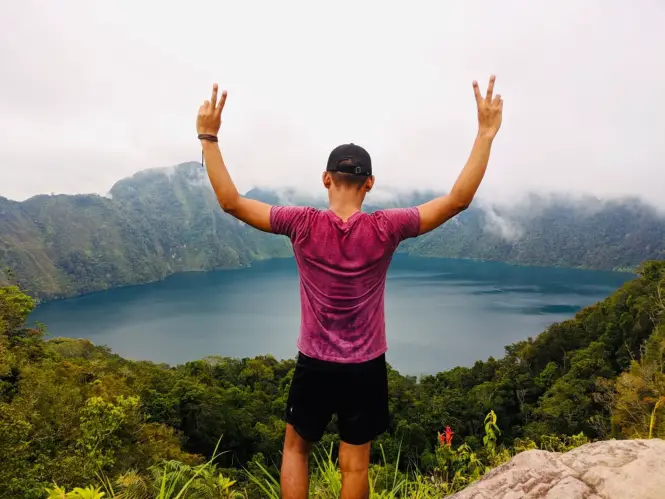
Here’s what you need to know about Lake Holon:
- Advanced registration is required. Only a maximum of 200 people are allowed to visit Lake Holon per day.
- If going via Kule Trail, you need to be at the tourism office by 12 noon. Later visitors are not allowed.
- If you’re a solo traveler, you can join up with other people so you can share the fees for the guides.
- There are no commercial accommodations in Lake Holon. There is only a campsite where you can set up a tent. There are small bathrooms and toilets, but they may not be maintained well. Just manage your expectations and enjoy the simplicity of the campsite.
- There is no electricity and no mobile signal.
- Activities include swimming, kayaking, fishing, “fish spa” with the small fishes in the lake, and horseback riding. You can also set up a bonfire at night.
- It’s best to visit on weekdays if you want to have the place for yourselves.
- There are often heavy rains in August and ber-months. If you plan on going on these months, it’s best to start your trek early so you have more time allowance.
And here more reminders:
- Make sure that you’re physically fit and you are experienced in trekking. Kule Trail is especially challenging.
- Practice the LNT (leave no trace). Be respectful and bring your own garbage bag so you can collect your trash. You will be required to give a fee for garbage (around P350 per person) at the tourism office, which will be refunded once you get back with your trash.
Things to bring
Here are the things you should bring:
- Tent and a tarpaulin/cover, in case it rains at night. You can also rent a tent at the tourism office.
- Bring your own food & water, cookware, and utensils. Drinking water is available at the campsite. There is also a sari-sari store where you can purchase basic goods, but expect the items to be pricier than usual. On mornings, you can buy fresh tilapia from local fishers for breakfast.
- Jacket because it gets really cold at night.
- Drybag to waterproof your items, in case it rains.
- Other essentials such as flashlight, powerbank, and full batteries for your camera.
- Garbage bag.
Remember that you need to bring all your essentials, but at the same time, do your best to pack light. If you do not want to carry your things, you can get a porter for a reasonable fee.
Budget and expenses
Here are the current expenses (Updated as of 2020):
| Fees / rates | Tourism office fees: – Entrance fee: P100 per person – Environment fee: P50 per person Campsite: – Ground rental at campsite (where you will pitch tents): P100 |
| Transport / trekking | Habal-habal from tourism site to jump-off point: – Kule: P550 – Salacafe: P400 Tour guide fees for trekking: – Kule: P600 / 10 pax – Salafe: P400 / 10 pax (Optional) Porter fee: P25 per kg *You can also go on a horseback ride from campsite to jump-off point via Salacafe Trail for P400 per person Boat fee to campsite: P50 per person |
| Others | Here are optional fees: Tent rental: P100 per tent + P100 for cover Kayaking with guide: P200 per hour Freshly caught tilapia: P50 per kilo (or depending on the day’s catch) |
In a group, a safe budget for an overnight trip is around P2500-3000 per person.
Contact
For reservation and other inquiries, you can contact the Lake Holon Tourism.
Has this guide to Lake Holon in South Cotabato been helpful to you? If you have questions or comments, let us know in the comments section below!
What to read next:
Interested in climbing? Here are other climbing/trekking articles:
- Mount Pulag
- Mount Kupapey (Mountain Province)
- Nagpatong Rock (Tanay, Rizal)
- Mount Mabilog (San Pablo, Laguna)
- Lake Holon (Tboli, South Cotabato)
Others:
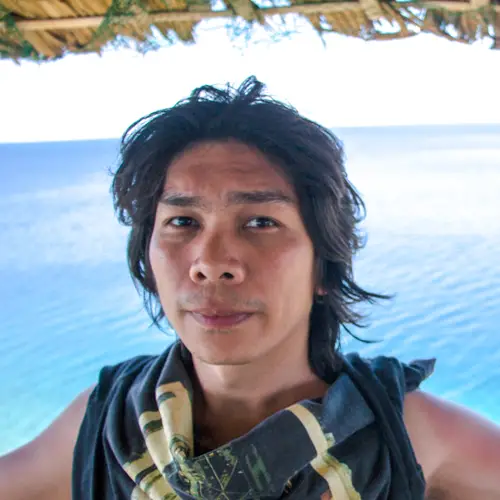
Hali Navarro is a backpacker and outdoor enthusiast. He is also a 2D/3D animator. He likes backpacking and adventure activities like hiking, swimming, and cliff jumping. He claims to have a personal army of ants.



